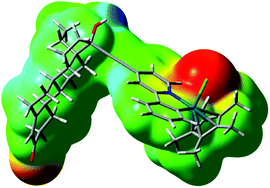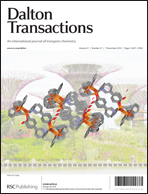Novel C,N-chelate rhodium(iii) and iridium(iii) antitumor complexes incorporating a lipophilic steroidal conjugate and their interaction with DNA†
Abstract
The novel steroidal conjugates [M(η5-C5Me5)Cl(LEV-ppy)] (M = Rh (1) and Ir (2)) bearing the lipophilic levonorgestrel group 17-α-[2-phenylpyridyl-4-ethynyl]-19-nortestosterone (LEV-ppy), where the chelating ligand is N and C-bound, have been prepared and characterized. Both compounds are more active than cisplatin (about 6-fold) in T47D (breast cancer) at 48 h incubation time. On the other hand, very low resistance factors (RF) of 1 and 2 in A2780cisR (cisplatin-resistant ovarian carcinoma) at 48 h were observed (RF = 0.9 and 1.1, respectively). The iridium steroidal compound 2 is twice as active as the non-steroidal analogue 2′, whose promising anticancer activity has recently been reported by Sadler. Theoretical DFT calculations on complexes 1 and 2 at the B3LYP-D/def2-TZVP-ecp level of theory show that the strongest bond to the metal atom is the η5-interaction to the Cp* ligand and that both of them feature a rather strong metal–chlorine bond. The new steroidal conjugates 1 and 2 are able to bind to DNA according to Hoechst 33258 displacement experiments and ESI-TOF MS spectrometry studies. Complexes 1 and 2 are also cathepsin B inhibitors, an enzyme implicated in a number of cancer related events.


 Please wait while we load your content...
Please wait while we load your content...